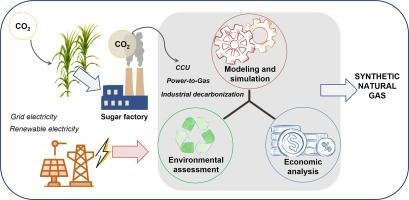Simulation-based techno-economic and environmental evaluation of synthetic natural gas production integrated with sugarcane processing
IF 3.9
2区 工程技术
Q2 COMPUTER SCIENCE, INTERDISCIPLINARY APPLICATIONS
引用次数: 0
Abstract
Dependence on fossil fuels is accelerating climate change and has spurred interest in carbon capture and utilization, which converts CO2 into products such as synthetic natural gas (SNG) that fit seamlessly into existing infrastructure. Despite efficient routes such as biomass gasification and Power-to-Gas, high costs have slowed adoption. In the Argentine sugar industry, biogenic CO2 from sugarcane processing presents an opportunity to produce low-carbon SNG. This study proposes to evaluate the feasibility of SNG production in sugarcane biorefineries through a combined techno-economic and environmental analysis. By capturing CO2 from biomass combustion and by combining it with hydrogen, sugarcane-processing facilities could serve as carbon sinks and reduce reliance on fossil fuels, contributing to broader decarbonization goals. Two scenarios are considered, green SNG and gray SNG, which differ in the source of electricity, renewable and current grid electricity, respectively. The green SNG system significantly reduces greenhouse gas emissions and fossil resource use by using renewable H2 and biogenic CO2, while the gray SNG system has a higher environmental impact due to its reliance on the current Argentine fossil-based electricity. The proposed process achieves an overall feedstock conversion of approximately 97%, which supports its technical feasibility. In addition, preliminary cost considerations are presented, outlining the economic challenges for large-scale implementation. The study also notes that the sustainability of SNG production from biogenic CO2 depends on the carbon intensity of the electricity grid, underlining the importance of transitioning to renewable energy to maximize environmental benefits.

基于仿真的合成天然气生产与甘蔗加工一体化技术经济环境评价
对化石燃料的依赖正在加速气候变化,并激发了人们对碳捕获和利用的兴趣,这种技术将二氧化碳转化为合成天然气(SNG)等产品,可以无缝地融入现有的基础设施。尽管诸如生物质气化和电制气等高效途径,但高成本阻碍了采用。在阿根廷制糖业,甘蔗加工产生的生物二氧化碳为生产低碳煤制天然气提供了机会。本研究建议通过结合技术经济和环境分析来评估甘蔗生物炼制厂生产煤制气的可行性。通过从生物质燃烧中捕获二氧化碳并将其与氢结合,甘蔗加工设施可以作为碳汇,减少对化石燃料的依赖,有助于实现更广泛的脱碳目标。考虑了两种情景,绿色煤制天然气和灰色煤制天然气,分别在电力来源、可再生能源和当前电网电力方面有所不同。绿色煤制天然气系统通过使用可再生氢气和生物源二氧化碳,显著减少了温室气体排放和化石资源的使用,而灰色煤制天然气系统由于依赖于目前阿根廷的化石电力,对环境的影响更大。提议的工艺实现了大约97%的总体原料转化率,这支持了其技术可行性。此外,还提出了初步的费用考虑,概述了大规模实施的经济挑战。该研究还指出,利用生物二氧化碳生产煤制天然气的可持续性取决于电网的碳强度,强调了向可再生能源过渡以最大限度地提高环境效益的重要性。
本文章由计算机程序翻译,如有差异,请以英文原文为准。
求助全文
约1分钟内获得全文
求助全文
来源期刊

Computers & Chemical Engineering
工程技术-工程:化工
CiteScore
8.70
自引率
14.00%
发文量
374
审稿时长
70 days
期刊介绍:
Computers & Chemical Engineering is primarily a journal of record for new developments in the application of computing and systems technology to chemical engineering problems.
 求助内容:
求助内容: 应助结果提醒方式:
应助结果提醒方式:


